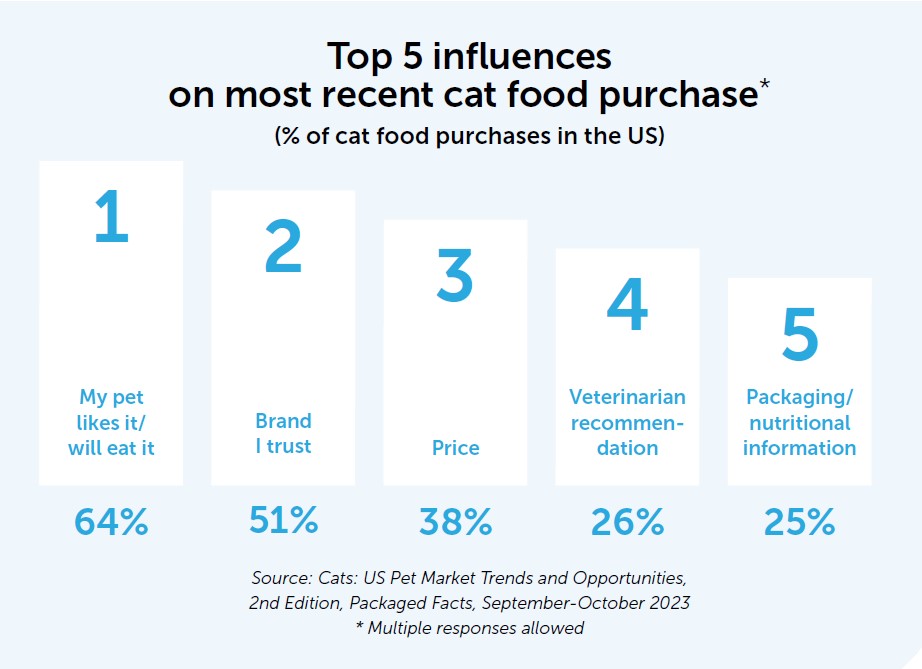Why it’s time to pay attention to cats

Insights from a US survey show that pet food manufacturers can seize new market opportunities by meeting cat owners’ rising demands, especially in relation to product choice, quality and healthfulness.
Given the recent decline in the US dog population, it’s no surprise that marketers are turning their attention to the pet industry’s other main segment: cats.
According to a 2024 survey by market research company Packaged Facts, 43% of cat owners believe that they are treated like second-class citizens by pet food manufacturers and would like to see the same product selection and quality as dog owners.
So, what are cat owners looking for, specifically?
What influences cat food purchases?
The survey shows that their pet’s preference is the greatest influence on cat food purchases made by American cat owners.
When asked about the strongest influences on their most recent cat food purchase, the majority of cat food buyers select: ‘My pet likes it/will eat it’. Trust in a specific brand is also an important factor, while price rounds out the top 3.
Although many cat owners trust their veterinarian for information about cat food, fewer rank vets among the top influences on their actual purchases.
Looking for deals
Unsurprisingly, given the economic environment of the past several years, cat owners are on the lookout for deals. In some cases, owners have been trading down to lower-cost products, including private labels.
When asked in the survey about significant challenges to pet ownership, approximately 40% of cat owners selected the high price of pet food, making it the top-ranking answer.
This corresponds with Packaged Facts’ survey results from September-October 2023, which showed that nearly a third of cat owners had switched pet foods in the previous 12 months.
Among those who had switched, 19% had traded down to a lower-priced national brand of cat food and an additional 9% had traded down to a lower-priced private label product.
Strong growth in private label
As inflation and an unsteady economy continue to put long-term pricing pressure on all pet categories, private label products are well positioned to leverage their status as affordable options.
According to the latest report from the Private Label Manufacturers Association (PLMA) for the 52 weeks ending on 19 August this year, overall store brand volume in the pet care department was $5.3 billion (€4.9B), representing an increase of 3.8%.
Meanwhile, store brand unit sales were up by 4.5%. However, cat food was a standout performer, rising by 10.1%.
All these figures indicate that the typically very high level of brand loyalty in the cat food market may be weakening to some degree.
Nevertheless, it is important to note that while cat owners may be interested in lower prices, they are not willing to sacrifice quality. Instead, they want products that promise value for money.
Preferred types of cat food
Despite cost concerns, the shift towards alternative forms of super-premium cat food is well underway, with fresh (refrigerated and/or frozen) and freeze-dried (or air-dried) pet food leading the charge.
The figures for dry food/kibble are similar across both pet segments, with around 90% of cat owners and dog owners using it, but cat owners are significantly more likely to use wet foods (64% compared with 42% among dog owners).
In fact, wet food usage among cat owners has risen by 3 percentage points since Packaged Facts’ 2022 survey, with dry food usage holding steady.
While traditional kibble and wet foods continue to dominate pet food sales by a wide margin, the September-October 2023 survey showed that a growing number of cat owners report purchasing cat food in alternative forms, including fresh/refrigerated (14%) and fresh/frozen (10%).
Interest in health and wellness
One trend running through all types of cat food is customized diets, which are favored by 10% of owners. This interest in alternative food formats is spurred by an overarching interest in pet health and wellness.
The survey results also show that 68% of cat owners are worried about the healthfulness of highly processed pet foods.
Despite the apparent rise in interest among cat owners in fresh (typically described as ‘gently cooked’) food for their pets, the uptake hasn’t yet reached the same level as for fresh dog food.
This is likely due to major players such as Freshpet, The Farmer’s Dog and Nom Nom remaining distinctly dog oriented.
For example, Freshpet’s cat-focused offerings are minimal compared to its dog-focused products. A search of its website in mid-2024 brought up just 7 products for cats compared to 55 for dogs.
Perhaps even more tellingly, the company’s presentation of earnings for Q1 2024 does not contain a single image of a cat – only dogs and dog food. In fact, there is no mention of cats at all.
Key takeaways
Pet food marketers have traditionally relegated cats to secondary status in the US. This can partly be explained by the relatively small size of the country’s cat population, and the fact that cats are also physically smaller and therefore need less food than dogs.
However, due to a drop in dog ownership levels, it’s time for pet food marketers who are interested in maintaining sales volume to start paying greater attention to cats.
After all, cat owners love their pets just as much as dog owners do and are just as willing to spend money on them. A wider choice of high-quality and healthful foods that also offer value for money is exactly what the cat food market needs right now.


